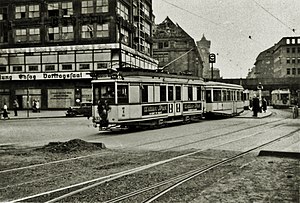BSt type 1928
| BSt type 1928 BM 28/35, BM 28/37 |
|
|---|---|
|
TM 36 and BM 28/37 at Alexanderplatz, 1944
|
|
| Numbering: | 851 II –880 II (BM 28/35) 881 II –900 II (BM 28/37) |
| Number: | 50 sidecars |
| Manufacturer: |
C&U (BM 28/35) LHB (BM 28/37) |
| Year of construction (s): | 1928-30 |
| Retirement: | 1967 (BVG West) 1968 (BVG East) |
| Gauge : | 1435 mm ( standard gauge ) |
| Length over buffers: | 11 640 mm |
| Length: | 11 200 mm (car body) |
| Height: | 3120 mm |
| Width: | 2200 mm |
| Fixed wheelbase: | 3500 mm |
| Wheel diameter: | 650 mm |
| Brake: | Knee lever caliper brake |
| Coupling type: | Albert coupling |
| Seats: | 34 |
| Standing room: | 36 |
| Floor height: | 380/450 mm (original) 400/560 mm (BM 28/35) 430 /? mm (BM 28/37) |
As construction in 1928 which led Berlin tram-GmbH (from 1929: BVG ) two series of 50 tram - sidecar with central entrance. The vehicles were manufactured between 1928 and 1930 and were used by the Berlin transport company until 1967 and 1968, respectively . No vehicles have been preserved.
history
From 1926 on, the Berlin tram started to buy more vehicles with central entry. She hoped that the central entrance and the large central platform would give the conductors a better overview of the cars. After a first series of 50 four-axle sidecars ( design 1926 , from 1934: BDM 26), a further 50 sidecars were ordered from Linke-Hofmann-Busch (20 cars) and Christoph & Unmack (30 cars) from 1928 . The cars were equipped with loose wheel sets . The axles, each 340 millimeters long, were held at the ends by strong spherical roller bearings and the bearing housings opposite each other were connected by a cast steel frame. This hung on the laterally cast tabs of the axle bearings and was attached to them with support bolts. Half leaf springs on which the car body rested were attached to the ends of the frame in the direction of the center plane of the wheel surface . In addition, three coil springs and rubber buffers were interposed to reduce brief vibrations and noises. To maintain the gauge , the opposite wheels were each connected with two U-rails as track holders . A friction buffer was installed between these to absorb side impacts. The cars were braked by means of toggle brakes attached to the roller bearing housings . These were located under the bench seats and were therefore accessible from the interior of the car. The brake could be released via the handbrake lever, electrically via the core brake and automatically via the spring brake.
Due to the low entry height of 400 millimeters for the time and the shape that rises towards the ends of the wagons, they were nicknamed "submarines" by the population. In the entry area, the car floor was 380 millimeters above the top of the rails and, with a three percent incline, rose by 70 millimeters towards the ends of the car, as the coupling height could not be reduced. Since the wagon wheels protruded far into the passenger compartment, longitudinal benches were built in; the layout was therefore similar to the four-axle sidecars of the 1926 design.
In the case of the cars manufactured by C&U, the aprons were pulled down to the side, while on the LHB cars they followed the floor of the car. In contrast, the LHB cars were equipped with ventilation flaps over the windows. In 1935 and 1937, respectively, the idler gears were replaced by conventional axles. According to the BVG type code from 1934, they were given the designation BM 28/35 or BM 28/37 after the conversion .
During the Second World War , the wagons were used for city freight transport. The BVG had to decommission a total of eight cars after damage. When the BVG was separated from the administration on August 1, 1949, nine sidecars remained with BVG-Ost and the remaining 33 sidecars with BVG-West. The vehicles used in West Berlin could be found in passenger traffic until about 1966 and were then taken out of service. The wagons that remained in East Berlin were included in the Reko program in 1968 and officially listed as donor vehicles for type BE 59/4 sidecars.
Individual evidence
- ^ A b E. Kindler: New sidecars of the Berlin tram . In: Verkehrstechnik . No. 20 , May 16, 1930, pp. 244-247 .
- ^ Reinhard Schulz: Tram in turbulent times. Berlin and its trams between 1920 and 1945 (part 2) . In: Verkehrsgeschichtliche Blätter . No. 5 , 2005, p. 133-143 .
- ^ Karl-Heinz Gewandt: Without axles - but boarding comfortably . In: Tram magazine . August 2013, p. 45-47 .
- ^ Reinhard Schulz: Tram in turbulent times. Berlin and its trams between 1920 and 1945 (part 3) . In: Verkehrsgeschichtliche Blätter . No. 6 , 2005, p. 174-183 .
- ↑ Marcel Götze: Post-War History 1960–1969. In: Berlin-Straba.de. Retrieved October 15, 2016 .
- ↑ Marcel Götze: BM 28/35 (851-880). In: berlin-straba.de. Retrieved March 11, 2019 .
- ↑ Marcel Götze: BM 28/37 (881-900). In: berlin-straba.de. Retrieved March 11, 2019 .
